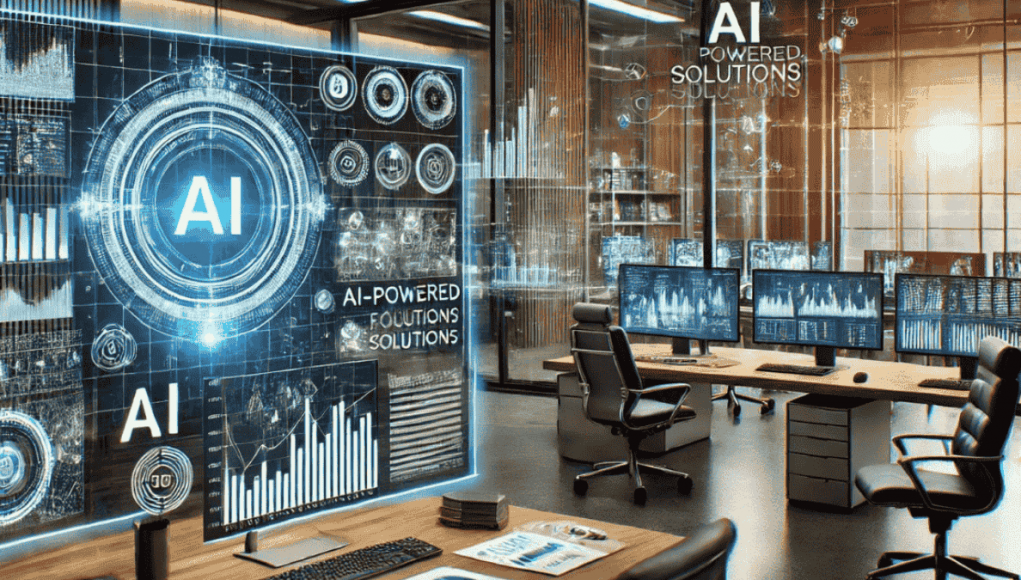In today’s fast-paced business landscape, companies face the constant challenge of accurately predicting future trends, sales, and demands. This is where Top AI Solutions for Business Forecasting come into play. By harnessing the power of artificial intelligence, businesses can tap into advanced predictive models, streamline decision-making, and stay ahead of market changes. The integration of AI not only enhances accuracy but also reduces human error, which is often a barrier in traditional forecasting methods.
Business forecasting with AI involves leveraging machine learning algorithms, deep learning, and data analytics to project future business outcomes based on historical data. Whether it’s predicting future sales, managing inventory levels, or optimizing financial planning, AI-driven forecasting solutions are revolutionizing the way companies operate. In this article, we will delve into some of the top AI solutions for business forecasting that have proven to be transformative for organizations across industries.
Benefits of Using the Top AI Solutions for Business Forecasting
- Increased Accuracy: AI tools can analyze vast amounts of data with precision, leading to more reliable forecasts.
- Improved Efficiency: By automating forecasting processes, businesses save time and reduce operational costs.
- Better Decision-Making: AI-driven insights allow companies to make data-backed decisions that drive growth and success.
- Scalability: These solutions are adaptable to businesses of all sizes, providing flexibility as operations expand.
- Real-Time Analysis: Many AI tools offer real-time forecasting, allowing businesses to respond to market shifts immediately.
15 Top AI Solutions for Business Forecasting
With AI’s potential to revolutionize business forecasting, a number of powerful tools have emerged to help businesses make data-driven predictions. Below, we will explore 15 tTop AI Solutions for Business Forecasting designed to provide accurate forecasting, improve decision-making, and drive growth. Each tool brings its own unique features, enabling organizations to choose the best fit based on their specific needs.
1. Prophet
Prophet, developed by Facebook, is an open-source time series forecasting tool that has gained popularity for its user-friendly interface and robust performance. It was designed to make forecasting accessible to both technical and non-technical users, providing a flexible platform for businesses to predict trends such as sales, demand, and other time-dependent variables. Built for simplicity and accuracy, Prophet is particularly useful for applications where historical data shows strong seasonal effects and holidays impact trends.
Key Features:
- Customizable Forecasting: Allows users to adjust parameters like seasonality and holidays to enhance prediction accuracy.
- Handling Missing Data: Automatically deals with missing data points and outliers, making it ideal for real-world messy datasets.
- Scalability: Easily scales to handle large datasets and can be deployed in different environments.
- Visual Outputs: Provides intuitive, easy-to-understand charts and graphs.
- Cross-Platform Compatibility: Available in Python and R, integrating easily with other data tools.
Pros:
- Open-source and free to use.
- Highly customizable.
- Can handle irregular data.
Cons:
- Limited support for non-linear trend forecasting.
- Requires a good understanding of time series data.
2. Amazon Forecast
Amazon Forecast is a fully managed service that uses machine learning to deliver highly accurate forecasts. The service automatically discovers how data such as product demand, sales, or revenue interact, and uses this to create precise forecasting models. With deep learning models that are ready to use, Amazon Forecast eliminates the need for manual model creation and tuning, making it accessible to all business sizes.
Key Features:
- Automatic Machine Learning (AutoML): Automatically trains and tunes models, simplifying the forecasting process.
- Time Series Forecasting: Built specifically for time-based data, making it perfect for sales and demand prediction.
- Integration with AWS: Seamlessly integrates with AWS services like S3 and Redshift.
- Customizable Models: Provides the flexibility to use pre-built models or develop custom ones.
- Multi-Variable Forecasting: Leverages related data, such as pricing and product promotions, to enhance accuracy.
Pros:
- Easy integration with existing AWS infrastructure.
- Highly accurate and scalable.
- Reduces the complexity of model development.
Cons:
- Cost can increase with usage.
- Requires knowledge of AWS ecosystem for optimal use
3. IBM Watson Studio
IBM Watson Studio offers a comprehensive environment for data scientists, developers, and business analysts to collaborate on AI projects. This AI-powered platform provides tools for building, training, and deploying machine learning models efficiently. Whether you’re a beginner or an expert, Watson Studio simplifies the creation of forecasting models using its automated machine learning (AutoAI) feature. It is known for its robust model management capabilities, allowing teams to work with both open-source and proprietary frameworks like PyTorch, TensorFlow, and scikit-learn.
Key Features:
- AutoAI: Automates data preparation, model selection, and hyperparameter optimization, speeding up experimentation.
- Collaboration Tools: Facilitates teamwork with shared workspaces and Jupyter notebooks.
- Data Governance: Provides AI governance tools for model transparency and compliance.
- Visual Modeling: Features drag-and-drop model-building tools for those without coding expertise.
- MLOps: Full lifecycle management for machine learning models, from development to deployment.
Pros:
- Wide integration with open-source tools.
- Strong focus on governance and compliance.
- Comprehensive suite of tools for data science and AI development.
Cons:
- Steep learning curve for beginners.
- High dependency on clean and accurate data
4. SAP Analytics Cloud
SAP Analytics Cloud is a business intelligence platform that integrates analytics and planning with unique predictive capabilities powered by AI. It is designed to offer deep insights into business operations, helping users to make better-informed decisions. The platform is particularly useful for businesses that want to connect their forecasting efforts with strategic planning, allowing them to seamlessly transition between insight generation and action planning.
Key Features:
- Predictive Analytics: Uses machine learning algorithms to detect patterns and forecast trends.
- Integrated Planning: Combines forecasting with financial and operational planning tools.
- Interactive Dashboards: Intuitive visualizations that help non-technical users understand trends.
- Collaboration Tools: Enables users to collaborate on plans and share insights across teams.
- AI-driven Forecasting: Automates data analysis and offers predictive suggestions.
Pros:
- Seamless integration with other SAP tools.
- Combines analytics and planning in one platform.
- Strong data visualization capabilities.
Cons:
- Can be complex to set up for non-SAP users.
- Costly for smaller businesses
5. Google Cloud AI Platform
Google Cloud AI Platform provides a suite of machine learning services for building, training, and deploying models at scale. It offers powerful tools for data scientists to create custom machine learning models for forecasting and other predictive tasks. Google’s extensive suite of APIs and its integration with TensorFlow make this platform ideal for businesses looking for flexible and robust forecasting solutions.
Key Features:
- AutoML: Simplifies model building for non-experts by automating model selection and training.
- TensorFlow Integration: Deep integration with TensorFlow for building deep learning models.
- Hyperparameter Tuning: Automatic hyperparameter optimization to improve model accuracy.
- Pre-Trained Models: Access to pre-built models for specific forecasting tasks.
- Scalability: Built to handle massive datasets and complex models.
Pros:
- Strong integration with Google’s other cloud services.
- Excellent scalability for large datasets.
- Pre-built models for quick deployment.
Cons:
- Requires advanced knowledge for custom models.
- Pricing can become expensive at scale
6. Microsoft Azure Machine Learning
Microsoft Azure Machine Learning (Azure ML) is a cloud-based platform designed to simplify the machine learning lifecycle. It offers tools to build, train, and deploy machine learning models with ease. It supports a range of frameworks like PyTorch and TensorFlow, making it suitable for advanced users. Azure ML also caters to beginners by providing no-code solutions through AutoML, helping businesses develop and deploy forecasting models efficiently.
Key Features:
- AutoML: Automates feature engineering and model building, ideal for users with little machine learning experience.
- MLOps: End-to-end model management and deployment tools, ensuring seamless operations.
- Integration with Azure Services: Works seamlessly with other Azure products such as Azure Data Lake and Azure Synapse.
- Model Monitoring: Allows real-time monitoring and re-training of models.
- Visual Interface: Users can build models with a drag-and-drop interface, simplifying model creation.
Pros:
- Excellent integration with the Microsoft ecosystem.
- Scalable to meet the needs of enterprises.
- No-code options are available for non-experts.
Cons:
- Can become expensive for large-scale projects.
- Requires familiarity with the Azure environment for advanced features.
7. Tableau
Tableau, now part of Salesforce, is renowned for its data visualization and business intelligence capabilities. It empowers organizations to turn data into actionable insights through intuitive dashboards and reports. As it incorporates more AI-driven features, Tableau is evolving into a powerful forecasting tool, enabling users to make predictions and create data-driven strategies with ease.
Key Features:
- AI-Powered Insights: Tableau’s built-in AI features offer predictive insights with minimal manual intervention.
- Interactive Dashboards: Users can create dynamic visualizations that are easy to share and interpret.
- Real-Time Data Analysis: Integrates with live data sources for up-to-date insights.
- Seamless Integration with Salesforce: Provides a comprehensive solution for sales and business forecasting.
- Cross-Platform Compatibility: Works with various databases and cloud platforms.
Pros:
- Excellent data visualization capabilities.
- Intuitive interface with minimal learning curve.
- Strong integration with Salesforce CRM.
Cons:
- Advanced analytics may require additional tools.
- Pricing can be high for smaller businesses.
8. RapidMiner
RapidMiner is a full-cycle data science platform that simplifies the process of building predictive models. It offers both no-code and code-based environments, making it accessible for a wide range of users. RapidMiner covers the entire predictive analytics process, from data preparation to model deployment, and is known for its ease of use, especially for businesses looking to quickly implement forecasting solutions.
Key Features:
- No-Code Environment: Drag-and-drop functionality for users with no coding experience.
- Pre-built Models: Comes with a range of pre-built templates for forecasting and predictive analytics.
- Data Preparation Tools: Built-in tools for data cleansing, transformation, and preparation.
- AutoML: Automates the selection, training, and optimization of machine learning models.
- Real-Time Forecasting: Supports real-time data integration and forecasting.
Pros:
- User-friendly for non-coders.
- Comprehensive range of tools from data preparation to deployment.
- Scalable for large datasets.
Cons:
- Advanced features may require additional plugins.
- Limited customization for expert users.
9. DataRobot
DataRobot is an automated machine learning platform that allows businesses to quickly build, deploy, and manage AI models. Using its Augmented Intelligence features, DataRobot simplifies the process of creating predictive models, even for non-technical users. It offers tools to automate the forecasting process, helping organizations make data-driven decisions more efficiently.
Key Features:
- AutoML: Automates the machine learning process from data ingestion to model deployment.
- Time Series Forecasting: Optimized for time series data, perfect for sales and demand predictions.
- Model Interpretability: Offers explainable AI features to ensure transparency in predictions.
- Low-Code/No-Code Interface: Allows non-experts to build models without writing code.
- MLOps Tools: Facilitates model monitoring and re-training for continuous improvement.
Pros:
- Easy to use for beginners with minimal coding.
- Strong time series forecasting capabilities.
- Great for organizations needing rapid deployment.
Cons:
- May be expensive for small businesses.
- Limited control over model selection for expert users.
10. Pecan
Pecan is an AI-driven predictive analytics platform designed to help businesses leverage their existing data for accurate forecasts. It focuses on providing actionable insights to improve business operations such as sales, marketing, and customer retention. Pecan is particularly noted for its ability to be implemented without requiring a team of data scientists, thanks to its automation features.
Key Features:
- Pre-built Models: Comes with pre-trained models specifically tailored for business forecasting.
- BI Integration: Seamlessly integrates with business intelligence tools like Tableau and Power BI.
- Automated Model Building: Uses AutoML to automatically generate and optimize models.
- Data-Driven Insights: Provides actionable recommendations based on forecast results.
- No Data Science Expertise Required: Designed for non-technical users to easily build and implement models.
Pros:
- Easy to implement without needing a data science team.
- Pre-built models save time and effort.
- Strong focus on improving business outcomes like customer retention and revenue growth.
Cons:
- Limited customization for advanced users.
- Pricing can escalate with increased usage.
11. ClickUp
ClickUp is a highly versatile productivity tool that also offers forecasting features for businesses. While primarily known for project management, ClickUp’s forecasting templates enable companies to predict spending, revenue, and resource allocation. With its flexible and customizable dashboards, ClickUp allows teams to visualize their forecasts and adjust strategies accordingly.
Key Features:
- Forecast Templates: Pre-built templates for financial, resource, and sales forecasting.
- Custom Dashboards: Users can create personalized dashboards to track performance.
- Integration with Other Tools: Easily integrates with other tools like Slack, Google Drive, and Salesforce.
- Real-Time Data Updates: Dashboards update in real-time, providing current forecasts.
- Collaboration Features: Allows teams to work together on forecasting models.
Pros:
- User-friendly interface.
- Highly customizable templates for different forecasting needs.
- Great for smaller businesses or teams looking for integrated project management and forecasting.
Cons:
- Limited advanced analytics.
- Not as feature-rich as dedicated forecasting tools【8†source】.
12. Obviously AI
Obviously AI is a no-code machine learning platform designed to help businesses make predictions without writing code. It is particularly popular among non-technical users looking for a fast, intuitive way to forecast business outcomes like revenue or customer behavior. The platform focuses on simplifying AI so that anyone can use it to make accurate data-driven decisions.
Key Features:
- No-Code Platform: Build machine learning models without writing a single line of code.
- AutoML: Automatically selects and trains models for users.
- Data Integration: Easily integrates with data sources like Google Sheets, Salesforce, and Dropbox.
- Real-Time Predictions: Provides quick, real-time forecasts based on historical data.
- Security: Data is encrypted using AES-256 encryption for enhanced security.
Pros:
- Easy for non-technical users.
- No coding experience required.
- Real-time forecasting capabilities.
Cons:
- Limited customization options for advanced users.
- May not handle large datasets as efficiently as other tools.
13. Futrli
Futrli is a cloud-based forecasting tool that helps businesses, especially in accounting and finance, predict trends in revenue, cash flow, and operations. With its focus on providing daily updated predictions, Futrli allows businesses to plan for growth and adapt to changes in real-time.
Key Features:
- Daily Forecast Updates: Forecasts are updated daily with real-time data.
- Scenario Planning: Provides different forecasting scenarios to prepare for best and worst-case outcomes.
- Direct Integration with Accounting Software: Integrates with Xero and QuickBooks for seamless data flow.
- Freestyle Forecasting: Users can create customized forecasting models tailored to their specific needs.
- Visual Reporting: Generates clear, easy-to-understand reports.
Pros:
- Tailored for accounting and financial forecasting.
- Real-time updates keep forecasts current.
- Direct integration with popular accounting tools.
Cons:
- Primarily focused on financial data, limiting broader business use.
- Customization options are somewhat limited.
14. H2O AI
H2O AI is a leading open-source platform for artificial intelligence and machine learning, particularly known for its AutoML capabilities. It offers powerful tools for time series analysis and business forecasting. H2O AI allows users to build and deploy models on any platform, making it highly flexible for large-scale forecasting tasks. The platform’s real-time analytics and deep learning capabilities set it apart from many competitors.
Key Features:
- AutoML: Automates the process of building and tuning machine learning models.
- Distributed Machine Learning: Capable of processing massive datasets across multiple machines.
- Interpretability Tools: Provides detailed insights into how models make predictions, ensuring transparency.
- Real-Time Forecasting: Offers real-time predictions, especially useful for operational decision-making.
- Integration with Popular Frameworks: Works with frameworks like TensorFlow and PyTorch.
Pros:
- Ideal for large-scale, enterprise-level forecasting projects.
- Strong AutoML and time series forecasting capabilities.
- Transparent model interpretation, crucial for regulated industries.
Cons:
- Can be complex for beginners to grasp.
- Requires substantial computational resources for larger datasets
15. Qlik Sense
Qlik Sense is a powerful business intelligence and analytics platform that integrates AI-driven predictive analytics. Known for its associative data engine, Qlik Sense allows users to explore data in a way that is intuitive and flexible. Its active intelligence framework empowers users to not only see what happened in the past but also what is likely to happen in the future. Qlik Sense is highly regarded for its easy-to-use interface, which enables non-technical users to create reports and visualizations effortlessly, making it a popular choice for business forecasting.
Key Features:
- Associative Data Engine: Provides a unique way to explore data connections, helping users uncover hidden insights.
- AI-Driven Analytics: Built-in AI features deliver automated suggestions and predictive analytics.
- Self-Service Visualization: Offers drag-and-drop capabilities for creating interactive reports and dashboards.
- Active Intelligence Framework: Focuses on real-time data integration for dynamic decision-making.
- Collaborative Analytics: Allows multiple users to collaborate on dashboards and reports in real-time.
Pros:
- Intuitive interface suited for non-technical users.
- Powerful real-time analytics and forecasting tools.
- Highly flexible and customizable for various business needs.
Cons:
- Advanced predictive analytics may require additional configuration.
- Cost can be prohibitive for smaller businesses
Conclusion
As businesses continue to navigate the challenges of an ever-evolving market, investing in top AI solutions for business forecasting has become a critical component of long-term success. These Top AI Solutions for Business Forecasting not only enhance the accuracy of predictions but also empower organizations to be more agile, adaptive, and proactive. By implementing these advanced solutions, companies can future-proof their operations, streamline decision-making processes, and achieve sustainable growth.





